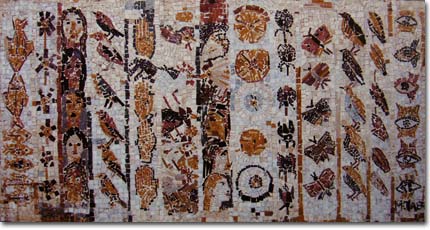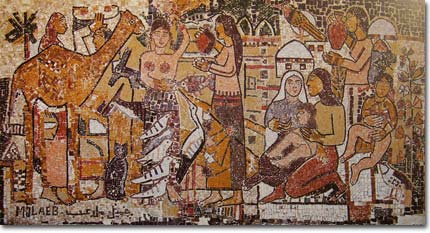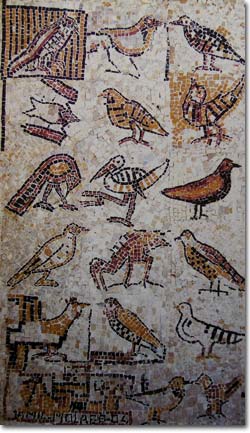My Journey
One day when I was four years old, I heard an overwhelming noise. I could not know whether it was the sound of airplane or some sudden great disaster. Frightened, I ran out of the house and into the garden, but wherever I ran the noise followed me. Crying and trembling from fear, I huddled in a corner, closed my eyes, and finally asleep from exhaustion. My parents looked for me everywhere, until they found me in the garden. Where did the noise come from? Why did such strong fear take hold of me? I did not know. I was four years old. It was at that moment that, for the first time, I became aware of my human existence and its mortal vulnerability.
I learned about my birth from conversations with my parents. I was born on the fourteenth of May in 1948, and my mother often recalled describing to the neighbors my strange behavior and how acutely sensitive I was as an infant. She said it was as though the spirit of another person was living in me, inhabiting the new body that she has brought into this world. This is how my mother described my birth - the emergence into life of a totally new, strange spirit.
How and when did I begin to love painting? My father, who had a passion for music, decided not to make it his career because of social and religious disapproval; instead, he became a house painter. And in my free time, as I helped my father with his work, paints and colors became familiar to me. The attic, where he stored his paints, was filled with fine powders stored in wooden boxes to retain their colors. And so, my love for painting began, a love that I carried with me to school. My teachers noticed how much I was attracted to drawing and using colors, and often remarked how well I could draw... etc... etc...
I passed the entrance exam for the Art Institute in 1968. My joy was great, and the Institute became my Eden, the Eden of art where artistic potentials can develop and rich experiences can be found. I spent four years painting, sculpting and studying. I lived with colors, seeing the marvelous rainbow of colors every day and preparing my eyes to create beauty... etc... etc...
In addition to developing my appreciation of the plastic arts, I also got to know the Greek music of Tiyadorakis, brilliantly performed in the film "Zorba the Greek." In literature, the works of Albert Camus deeply absorbed me at the time. I also received much cultural nourishment from the magazines Shiir, Mawakef, and Encounter. I got to know the poetry of Mohammed Maghout, which I loved; his poems were a great stimulant to my imagination.
I loved Adonis's poetry as well; he was and still is an encouraging friend. Other poets I liked: Mahmoud Darwish, for the beauty of his lyrical poetry; Beland Haidary, whose verse is astonishing; Khalil Hawi, for the wonders in his symbolic travels; Nizar Kabbani, for his romantic poetry, which continues to captivate teenagers; and Mohammed el Faitrouni, whose poems carry the pain of Africa and are songs of weeping.
During those fruitful years, I met the many art critics who played a major role in Lebanon's art movement, among them Nazih Khater, Ethel Adnan, Helen Khal, Samir el Sayegh, Cesar Nammour, Joseph Tarrab, Faisal Sultan, and Michel Naba', among others.
Of those wonderful years, I also remember being very impressed by The Peasant Diary of Amine Nakhle, its transparent sentences, clear words, lively imagination and the music embodied in his prose.
To keep up with my painting and also join in all the cultural activities in Beirut, I used to commute from my village in the mountains, and would often work late in the evenings. One evening at the Institute, I was working with a colleague, Elias Dib, when we lost track of time and were locked in. We had to look for the watchman to free us.
At the time, I searched for a scholarship to complete my studies abroad and strengthen my experience in art. I finally got one from the Government of Algeria. In 1972, I began this new phase in my life. My first challenge in Algeria was finding a place to live. After a long search, I found a small room in a humble hotel, but beyond its tight walls, the city opened its arms to me on scenes that I had never seen before, all bathed in a mixture of bright and strange light.... etc... etc...
In 1974, I exhibited the works produced in Algeria in Dar el Fan wal Adab in Beirut. At that point, I started searching for a new vision, based on nature and the people in my area. In Syria, especially in Germaneh and Sweideh, I painted houses and people attached in balance to their environment and the land around them. The medium of gouache was my favorite. With it, I painted women in their traditional costumes, rendering the Arabic geometric and floral decorations in my own style. I drew handicrafts, wedding boxes, trunks, windows and walls, the divan, stoves, carpets, and pillows. I saw in them a whole other world of beauty. These objects and dresses spoke to me in a humble spirit, without complications. I saw in the head wearing an Arab or pharonic headdress a continuation of what is found in museum-of all that our forefathers had done to produce a building or a sculpture. I thought of myself as one of them, as though I was carrying within me thousands of people and was responsible for their heritage. I felt like the high branch of a tree, responsible for its roots and the air around it.
I exhibited the collection produced in Syria and Lebanon at Contact Art Gallery, under the management of Cesar Nammour and Wadah Fares, as "Villages Scenes". This exhibition was remarkable for its clear colors and the close-to-heart character of its subjects.
I could not believe it when the war erupted in 1975. Is it enough to say that the Lebanese people just wanted change, change of the system of government, change of the world? We did not know what to expect; we did not know that once a war starts, it can continue out of control, and that the peace that follows will be harsh. It was all so senseless.
I tried to continue painting during those years. I lost many relatives and friends in the war; violent incidents multiplied and the country became drenched in a flood of blood. I drew in black with china ink and charcoal; I could not see color. I was the only way I could express my view of what was happening, the scenes of violence and the falling victims. In my drawings, I was recording a terrible history that we prayed would cease. But it went on every day for fifteen years.
I did a series of engravings and drawings of the war, but did not have the chance to exhibit them, since there were no galleries around. When Rafic Charaf saw the series at Horseshoe Café, he suggested that I title it "Diary of the Civil War". And so it was named.
During the first Israeli occupation in 1978, I produced another series of the war, which I exhibited at the Lebanese Association of Artists and Sculptors and then published in a book, titled "Close to the Nation".
In 1980, I shifted to working on woodcuts and completed thirsty works, which I printed under the title "End of Darkness and Beginning of Dawn". These prints were exhibited at Epreuve d'Artiste in 1982, under the direction of Amal Traboulsi. In them, I again expressed my feelings about the war, and the drama of the human spirit that still existed in the streets, alleys, and hidden killing corners of the city.
In 1983, David Tannous, the American art critic of Lebanese origin, visited Lebanon and was attracted by my woodcuts. He encouraged me to continue my studies in the United States, and this became my next aim. In 1984, I visited New York. While there, I learned about the prestigious Pratt Institute in Brooklyn and decided to submit an application to study engraving… etc… etc…
I visited Washington D.C., where I again met David Tannous, who urged me to exhibit at Aleph Gallery. I showed my latest engravings there, and among the people I met at the exhibition were the academician Hisham Sharabi, the writer Halim Barakat, and the painters Helen Khal and Kamal Boulatta… etc… etc…
The city made me acquire the habit of exaggerating shapes in my drawings, and gradually a photographic sense and pronounced space entered my paintings. The spirit of the city, so different and variable, became anchored in my paintings, as they inclined upward in a fast moving composition, as toward an act of dying that would not be repeated-like the candid shot of a swiftly moving object.
I completed in New York in 1984 an engraving of the skyscrapers of the World Trade Center. When they collapsed September 11, 2001, I was stuck by what I saw on the TV screen, how similar the images seemed to my earlier engraving: an airplane flying towards the towers, the towers collapsing, the scared faces of people running, the crowded cars and the storm of smoke rising in the sky of Manhattan. It was all as if I had seen it in the dream... etc... etc...
I started experimenting in computer drawing in 1987 in Brooklyn. My works were all in black and white, as laser color computer printing was not available then. I did about fifty works, employing readymade images, symbols and letters that were similar to my engravings and woodcuts. Utilizing the computer to produce graphic works was a natural development of photography, engraving, and printing. As painters, we can consider it an instrument that quickens and enriches the memory of images. We can utilize the computer fruitfully in the making of large colored murals, especially when the artist adds touches of the brush to give it more life and energy.
New York is a city that does not sleep. It taught me how to sleep with my eyes open so that I would not miss anything. I experienced this in many paintings; they seem to convey the feeling of strange wrestler, watching, somehow sad and afraid... etc... etc...
I always worry that life will suddenly stop. When I returned to Bayssour in 1989, I decided to paint natural scenes in gouache, in clear pure colors more daring than before. I also reprinted my woodcuts, added color to them, and finished many with a new approach to color. I exhibited this series at Dar el Nadwe in 1990. I then produced a series of paintings of nature and flowers in pastel and colored pencils, which I exhibited with some gouaches at Gallery Agial in 1993 under the management of Saleh Barakat. The collection was very well received, especially the prints which I executed on large stretches of cloth measuring up to two meters by one meter in size.
In 1994, I participated in a group exhibition to inaugurate the Janine Rebeiz Gallery, along with Chafik Abboud, Amine el Bacha, Aref el Rayyes, Halim Jurdak, and Yvette Achkar. My works in this exhibition were marked by clear colors and defined composition, as the critic as Nazih Khater described them. Since then, I have had ten exhibitions, featuring different subjects and material at this gallery. I consider my exhibition, "Sunday Walk", as the best of all. This show consisted of natural scenes and people painted in fifty different places in Lebanon and abroad where I had traveled.
My first painting exhibition that concentrated on the sea was in 1997. Titled "The Blue", the paintings showed the blue sea, the boats, the bathers, and seabirds. To me, the sea conveys feelings of the unknown, of traveling, of estrangement.
I always liked to travel, to get to know new places to paint. I visited Damascus, Aleppo and Latakia, and went around the Syrian countryside into village houses, and painted the peasant life. I traveled in 2000 to Egypt, where I painted the Nile and the Pyramids in Cairo, and the coastline of Alexandria.
On a visit to Baghdad in 2001, did a series of paintings that I exhibited at the Beirut Theater, as a demonstration against the pending war in Iraq. I also did a series of works about the sea in Bahrain, its ebb and tide, when I participated in the International Symposium of Sculpture that was held there.
I find traveling a source of inspiration, and very much appreciate getting to the intellectual atmosphere and artistic traditions of a country. I visited Istanbul in 2004, where I saw the remarkable sources of Ottoman art. I painted Aya Sophia and the Great Mosque and visited the major historical sites in a city that in itself seems like a museum... etc... etc...
Every day is an adventure, as is every painting. Therefore, I tend to want to freeze time in a painting. I cannot stop time, but I can arrest it in my paintings, in which I can the meaning of the moods and dreams that are contained in everything that goes beyond time.
Beyond frozen time, places, faces, friendships multiply. My body becomes inseparable from me. I awake it, as it awakens me; it questions me, as I question it; it travels with me into new horizons. Sometimes I make peace with it and sometimes I oppose it, sometimes I forgot it and sometimes it forgets me. It sends me to the doctor to find peace. Thus, beyond time, I free myself to dwell in the creation of a painting.
The encounter between the pen and the body, between the spirit and the material, between the real and the imaginary and the magic of dreams, worries me. I feel that I have to rest, but I find no rest except in work, with the brush and canvas, with color, the chisel and wood. I leave my body to dwell in shapes. I make painting my life, which gives me balance. I construct my friends in my paintings give them expressions truer than theirs. I try to write in my paintings the shorthand of beauty and self. I register voices to construct a world I quickly exchange with another in a painting, because of new dream, new images, awaken me. I carry my luggage like a sleep walker, while new images call me to dress them, to save them from neglect and the curse of disappearing into forgetfulness.
There is no rest for the body and soul of the artist except after the birth of another painting... etc... etc...
(Extract of Jamil Molaeb – A self portrait – Fine Arts Publishing, Beirut Lebanon - Artworks are as well copyrighted by Fine Arts Publishing)
Mosaics by Jamil Molaeb – A self portrait – Fine Arts Publishing, Beirut Lebanon
There exists a natural continuity between sculpting and painting. There is also continuity between tradition and modernism, between craft and creation. The colored square stones of mosaics give me a direct feeling of the texture of the material. It is like the relation of man with the walls of his house, like the terracing of the fields with the rocks. Man built his house with feelings for the stone, and did not commit mistakes in proportions. He worked with the available materials, using simple techniques. In the search for stones of different colors, there is an element that can only be found in the making of a mosaic. It is the sound of striking the stone to split it up into small pieces to fit into drawing that has been executed in charcoal or chalk. Most of my mosaic works deal with popular subjects, like celebrations, weddings, picking fruit, and harvesting. In the mosaic stones, I discover a new expressive language that has a long history, dating from ancient Greece, Roman, and Byzantine times to the Arabs in Andalusia and Persia. Mosaics reinvent themselves anew in every age and are forever changing.

Twelve Months - Stone mosaics, 200 x 110 cm, 2003

My Village - Stone mosaics, 115 x 225 cm, Entrance to Bayssour, 2004

Birds in my Memory - Stone mosaics, 124 x 71 cm, 2004
Coyright Jamil Molaeb – A self portrait – Fine Arts Publishing, Beirut Lebanon